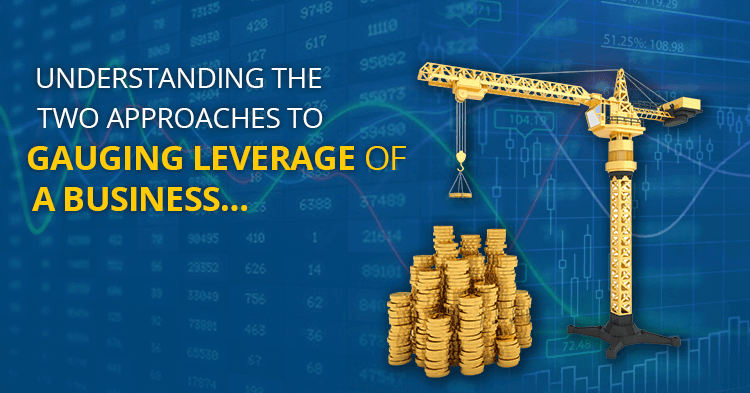
What do we understand by leverage? As the name suggests, it refers to the strategic use of debt (as a lever) to reduce your cost of capital. The logic here is that the cost of debt is lower than the cost of equity. As a result, by adding debt to your capital structure you end up reducing your average cost of capital. But does it always work that way? While it is true that debt cost less than equity, it also needs to be remembered that debt has a commitment in the form of interest and principal repayments. Hence in cyclicals businesses, this becomes a major source of financial risk.
What is gauging leveraging all about? Essentially, gauging leverage is about understanding this very delicate trade-off. How do you use leverage to reduce your average cost of capital but at the same time also ensure that it does not expose you to financial risk? Here, when we talk of financial risk we are referring to the probability that the company may not be able to service the interest and principal repayments through its existing cash flows. Effectively, there are two aspects to gauging leverage viz. evaluating the quantum of debt and evaluating the cost of debt.
Let us understand the concept of quantum of debt with a live illustration
|
Balance Sheet of Lever Ltd. for the fiscal year 2017-18 |
|||
| Liabilities | Amount | Assets | Amount |
| Equity Capital | 20,00,000 | Land | 30,00,000 |
| General Reserves | 30,00,000 | Building | 20,00,000 |
| Share Premium A/C | 10,00,000 | Plant & Machinery | 60,00,000 |
| Total Equity | 60,00,000 | Other LT Assets | 10,00,000 |
| Term Loans | 60,00,000 | Total Fixed Assets | 1,20,00,000 |
| Bonds | 30,00,000 | Cash on Hand | 15,00,000 |
| Long Term Debt | 90,00,000 | Bills Receivable | 20,00,000 |
| Current Liabilities | 15,00,000 | Inventories | 30,00,000 |
| Short Term Loans | 30,00,000 | Advances given | 10,00,000 |
| Short term Liabilities | 45,00,000 | Total Current Assets | 75,00,000 |
| Total Liabilities | 1,95,00,000 | Total Assets | 1,95,00,000 |
The liabilities side of the balance sheet consists of equity, long term debt and short debt. The assets side of the balance sheet consists of fixed assets and current assets. There are two approaches to measuring the quantum of leverage.
Total Leverage Ratio = Total Assets / Equity
Total Leverage Ratio = 1,95,00,000 / 60,00,000 = 3.25 times
This is a normal leverage for companies in sectors like metals, cement and capital goods which are capital intensive. However, in case of sectors that are more consumer-facing, these high levels of leverage are not called for. However, this approach to leverage can be quite misleading as it considers the total liabilities which is a mix of short term and long term liabilities. Normally, short term liabilities are financed by the current assets and hence do not really impact the financial risk of the company. What is a better way to look at quantum of leverage? It is pure leverage…
Pure Leverage Ratio = Long term debt / total equity
Pure leverage ratio = 90,00,000 / 60,00,000 = 1.50 times
The pure leverage ratio is more indicative of the quantum of leverage as it ignores the impact of current liabilities and only looks at the long term debt of the company. However, the second dimension that you need to understand about leverage is the cost of leverage.
To delve deeper into the concept of cost of leverage, let us look at how good he cash flows of the company are to cover the servicing of the debt. Look at the case study below…
| Particulars | Amount |
| Long Term Debt | Rs.90,00,000 |
| Cost of Debt | 9% |
| Annual Interest payout | Rs.8,10,000 |
| EBITDA of the Company | Rs.20,00,000 |
| Depreciation | Rs.10,00,000 |
| Earnings before Interest and Tax (EBIT) | Rs.10,00,000 |
| Interest Cost | Rs.8,10,000 |
| Profit before Tax | Rs.1,90,000 |
| Interest Coverage = EBIT / Interest | 1.23 times |
Before we get into the interest coverage review, here is an interest point to understand. Why have we considered EBIT instead of EBITDA, since depreciation is a non-cash charge? There is a reason for that. Why do we charge depreciation? It is charged so that the company gets tax shields on the depreciation write-off and that can be used to replenish the plant and machinery over time. Therefore you can use the depreciation generated funds. You reference has to be EBIT only.
In the above case, the interest coverage is quite precarious at 1.23. The EBIT just about covers the interest cost. Even though, the company is comfortable in terms of quantum of leverage, the cost of debt is quite high. Therefore the company needs to either focus on negotiating for a lower cost loan or they will have to reduce the quantum of debt. That is how leverage is gauged.
While understanding leverage there is another aspect of currency risk that needs to be understood. This is in case of foreign currency borrowings as in the case of External Commercial Borrowings (ECB) and Foreign Currency Convertible Bonds (FCCBs). If between the time the bond is issued and the bond is redeemed, if the INR depreciates against the US Dollar, then the rupee liability of the company can shoot up substantially. This is a unique risk pertaining to foreign currency borrowings that add to your leverage risk!
Enjoy Zero Brokerage on Equity Delivery
Join our 2 Cr+ happy customers
Enjoy Zero Brokerage on
Equity Delivery